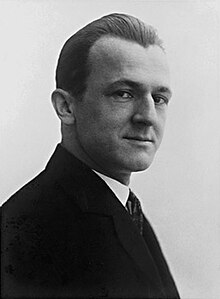Georg Grosz
| George Grosz | |
|---|---|

George Grosz in 1921
|
|
| Born |
Georg Ehrenfried Groß July 26, 1893 Berlin, German Empire |
| Died | July 6, 1959 (aged 65) West Berlin |
| Nationality | German, American (after 1938) |
| Education | Dresden Academy |
| Known for | Painting, drawing |
| Notable work | The Funeral (Dedicated to Oscar Panizza) |
| Movement | Dada, New Objectivity |
George Grosz (July 26, 1893 – July 6, 1959) was a German artist known especially for his caricatural drawings and paintings of Berlin life in the 1920s. He was a prominent member of the Berlin Dada and New Objectivity group during the Weimar Republic. He emigrated to the United States in 1933, and became a naturalized citizen in 1938. Abandoning the style and subject matter of his earlier work, he exhibited regularly and taught for many years at the Art Students League of New York. In 1956 he returned to Berlin where he died.
George Grosz was born Georg Ehrenfried Gross (German spelling Groß; German pronunciation: [ɡʀoːs]) in Berlin, Germany, the son of a pub owner. His parents were devoutly Lutheran. Grosz grew up in the Pomeranian town of Stolp (now Słupsk, Poland), where his mother became the keeper of the local Hussars Officers' mess after his father died in 1901. At the urging of his cousin, the young Grosz began attending a weekly drawing class taught by a local painter named Grot. Grosz developed his skills further by drawing meticulous copies of the drinking scenes of Eduard von Grützner, and by drawing imaginary battle scenes. From 1909 to 1911, he studied at the Dresden Academy of Fine Arts, where his teachers were Richard Müller, Robert Sterl, Raphael Wehle, and Osmar Schindler. He subsequently studied at the Berlin College of Arts and Crafts under Emil Orlik.
In November 1914 Grosz volunteered for military service, in the hope that by thus preempting conscription he would avoid being sent to the front. He was given a discharge after hospitalization for sinusitis in 1915. In 1916 he changed the spelling of his name to "de-Germanise" and internationalise his name – thus Georg became "George" (an English spelling), while in his surname he replaced the German "ß" with its phonetic equivalent "sz". He did this as a protest against German nationalism and out of a romantic enthusiasm for America – a legacy of his early reading of the books of James Fenimore Cooper, Bret Harte and Karl May – that he retained for the rest of his life. His artist friend and collaborator Helmut Herzfeld likewise changed his name to John Heartfield at the same time.
...
Wikipedia
